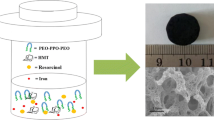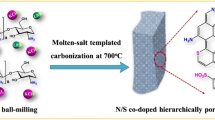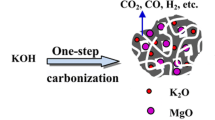Abstract
The nitrogen-doped hierarchically porous carbon monoliths (N-HPCMs) were successfully synthesized by using dicyandiamide (DCDA) as nitrogen source, phenolic resol as carbon precursor and mixed triblock copolymers as templates via a one-pot hydrothermal approach. The obtained carbon monoliths possess tunable mesopore size (4.3–11.4 nm), large surface area (552–660 m2/g), and high nitrogen content (up to 12.1 wt%). Ascribed to the nitrogen-doped frameworks and hierarchical porosity, N-HPCMs exhibit good electrochemical performance as the supercapacitor electrode with specific capacitance of 268.9 F/g (in 6 M KOH) at a current density of 1 A/g, and a 4.1 % loss of the specific capacitance after 5,000 charge–discharge cycles, indicating a long-term cycling stability. Such unique features make N-HPCMs promising electrode materials for high performance supercapacitors.
Similar content being viewed by others
Avoid common mistakes on your manuscript.
1 Introduction
As a new kind of energy-storage devices, supercapacitors have recently attracted increasing attention due to their high power density and long cycle life [1]. Because of high porosity and large surface area, porous carbon materials have been regarded as one of the most promising candidates for supercapacitor electrodes. To date, activated carbons are the most commonly used electrode materials for supercapacitors [2]. However, they suffer from a drawback of slow mass transfer due to the small micropores (<2 nm) and long diffusion pathways [3]. While, the mesopores (2–50 nm) can afford a short ion-transport pathway with a minimized resistance, and the macropores (>50 nm) are beneficial for the formation of ion-buffering reservoirs giving a decreased diffusion distance [4–11]. The combination of multi-level pores (micro-, meso-, and macropores) in carbon materials is expected to provide a harmonious electrochemical environment for the full realization of fast ion transport and high charge storage capability. Therefore, great endeavors have been made to design hierarchically porous carbons containing two or three types of pores and characterize their electrochemical capacitive properties [12–19].
However, most of the hierarchically porous carbon monoliths have hydrophobic surface and a limited number of specific active sites, which impedes their practical application. It has been demonstrated that the incorporation of nitrogen atoms into the carbon matrix not only changes the electronic properties of carbons but also produces additional functional groups on the carbon surface to improve the wettability, which consequently enhance the electrochemical performance of carbon materials [20–24]. Until now, some works have been reported on electrochemical properties of nitrogen-doped hierarchically porous carbon powders prepared mainly through nanocasting method [25] or chemical activation route [26]. The electrodes of these carbon materials are usually fabricated using a mixture of carbon powders and binders which lower the electrical conductivity and the electrodes are possibly broken into fragments during the charge–discharge cycles. In contrast to carbon powders, carbon monoliths are more advantageous for supercapacitors because no binders are needed due to their continuous skeletons [27].
To the best of our knowledge, there are still few works about the synthesis of nitrogen-doped hierarchically porous carbon monoliths (N-HPCMs) and the evaluation of their electrochemical properties [28]. To find a facile one-pot method to fabricate N-HPCMs is still challenging. In this report, we demonstrate a one-pot hydrothermal synthesis of N-HPCM by using dicyandiamide (DCDA) as nitrogen source, phenolic resol as carbon precursor and mixed triblock copolymers as templates. Furthermore, the electrochemical performance of N-HPCM-based electrodes has been systematically investigated. This facile and economical hydrothermal synthesis approach can be useful for the large-scale industrial production of porous carbon monolith materials with nitrogen-doped frameworks and hierarchical porosity for supercapacitor applications.
2 Experimental
2.1 Materials
Triblock copolymers Pluronic P123 (M w = 5,800, EO20–PO70–EO20) and Pluronic F127 (M w = 12,600, EO106–PO70–EO106) were purchased from Acros Corp. DCDA, phenol, formalin (37 wt%) and ethanol were purchased from Chongqing Huanwei Chemical Corp. All chemicals were used as received without purification.
2.2 Synthesis of N-HPCMs
The synthesis of N-HPCMs was carried out under hydrothermal conditions by using phenolic resols as carbon precursors, DCDA as nitrogen source and the mixed triblock copolymers as templates. Typically, 1.0 g of phenol and 3.5 mL of a formaldehyde solution (37 wt%) were dissolved in 5 mL of 0.5 M NaOH solution and stirred at 70 °C for 0.5 h. Then, an aqueous solution of mixed triblock copolymers (0.75 g P123 and 1.25 g F127 in 10 mL of water) and different amounts of DCDA (0–0.7 g) were added to the above solution, and the mixture was continuously stirred at 70 °C for 3 h. After that, the solution was poured into an autoclave and transferred into an oven at 100 °C for 12 h. The obtained polymeric monolith was collected by filtration, washed with water and dried in vacuum. The pyrolysis was carried out in a tubular furnace under N2 atmosphere at 600 °C for 3 h with a ramp rate of 1 °C/min. The samples were denoted as N-HPCM-x, where x was the mass of DCDA (g).
2.3 Characterization
Scanning electron microscopy (SEM) images were collected with a Hitachi S-3400N electron microscope operated at 20 kV. Transmission electron microscopy (TEM) experiments were conducted on a JEOL 2011 microscope operated at 200 kV. N2 adsorption–desorption was determined using a Tristar-3020 surface area analyzer. Nitrogen content analysis was carried out on an elemental analyzer (Vario EL III, Elementar).
2.4 Electrochemical measurements
The electrochemical experiments were carried out using a three-electrode system, employing platinum as the counter electrode, the saturated calomel electrode (SCE) as reference electrode and 6 M KOH solution as the electrolyte. The working electrode was prepared by fixing a thin piece of as-prepared carbon samples on a platinum plate. The cyclic voltammetry (CV), galvanostatic charge–discharge (GCD) and electrochemical impedance spectroscopy (EIS) tests were performed on a CHI 660D electrochemical analyzer at ambient conditions.
3 Results and discussion
3.1 Morphology and porous structure
Photographs of the as-synthesized polymeric monolith and the corresponding calcined carbon monolith (N-HPCM-0.3) show a very stable and crack-free bulk macroscopic appearance (Fig. 1). The polymeric monolith in Fig. 1a is 2.8 cm in diameter and 1.6 cm in height. After high-temperature calcination and removal of templates, the nitrogen-doped carbon monolith N-HPCM-0.3 maintains the regular cylinder-like shape (2.4 cm in diameter and 1.2 cm in height). The volume shrinkage is calculated to be about 45 %. The N-HPCM samples also have some degree of mechanical strength and can be cut into small pieces. So, it is convenient to test their supercapacitive properties without any conductive additive and binder.
SEM images (Fig. 2a, b) show that the structures of the as-synthesized polymeric monoliths are constructed from interconnected particles. These particles build up a 3-D macroporous framework, with sizes in the range of 2–6 μm. After carbonization at 600 °C under N2 atmosphere for 3 h, the macropore size of carbon monolith slightly increases (Fig. 2c, d). TEM images of N-HPCM-0.3 sample (Fig. 3) reveal that these building blocks are of an ordered 2-D hexagonal mesostructure.
N2 adsorption–desorption isotherms and pore size distribution of the carbon monoliths after calcination at 600 °C are shown in Fig. 4. N2 adsorption–desorption isotherms of the sample H-NMC-0 without adding DCDA show type-IV curves with a sharp capillary condensation step in the relative pressure range of 0.4–0.6 and H1-type hysteresis loop, indicative of uniform cylindrical pores. After the addition of DCDA, the capillary condensation step shifts to high relative pressure ranges, indicating that the pore size increases gradually. As the mass of DCDA increases from 0.1 to 0.7 g, the pore size dramatically increases from 4.3 to 11.4 nm (Fig. 4b; Table 1), indicating that higher amounts of DCDA can dramatically cause the expansion of mesopores. According to the literature [29], the larger pore size is beneficial to the accesses of electrolyte into the pores and ionic transportation. The BET surface area and pore volume of nitrogen-doped carbon monoliths are in the ranges of 552–660 m2/g and 0.46–0.66 cm3/g, respectively (Table 1). However, when the mass of DCDA is further increased (>0.7 g), the ordered mesostructures of N-HPCMs are degenerated.
3.2 Electrochemical performance
Figure 5 shows CV curves of N-HPCM-based electrodes at a sweep rate of 5 mV/s in 6 M KOH aqueous solution. For comparison, the CV curve of N-HPCM-0 is also included. It can be observed that all curves present a quasi-rectangular voltammogram shape, which indicates that N-HPCM materials have good electrochemical capacitive properties. It is noteworthy that the excellent supercapacitive performance can be ascribed to their hierarchical pore structure which facilitates fast mass transportation and decreases ion-transport resistance. Besides, the nitrogen-doped carbon monolithic electrodes possess the bigger inner integrated area than nitrogen-undoped electrode (N-HPCM-0). In general, at the same scan rate, a larger inner integrated area of the CV curve indicates a higher specific capacitance.
Figure 6 exhibits the GCD curves of the carbon monoliths at the current density of 1 A/g in 6 M KOH aqueous solution. It can be clearly seen that these charge–discharge curves are closely linear and show a typical triangle symmetrical distribution, revealing a good supercapacitive behavior and electrochemical reversibility, which is in well agreement with CV observations. Nevertheless, the charge–discharge time in one cycle of N-HPCM-0.3 electrode is much longer than that of N-HPCM-0 electrode, which directly indicates an obvious improvement in capacitance properties after the incorporation of nitrogen atoms.
The specific capacitance values for N-HPCM-0 and N-HPCM-0.3 electrodes obtained from the charge–discharge curves are shown in Fig. 7. The specific capacitance of N-HPCM-0.3 (268.9 F/g) at low current density of 1 A/g is higher than that of N-HPCM-0 sample without nitrogen modification (147.9 F/g), which suggests that the supercapacitive performance is greatly improved due to the incorporation of nitrogen into the carbon framework. The doped nitrogen can improve the wettablility and modify the electronic properties of the carbon monoliths, thus leading to excellent supercapacitive performances. It should be noted that the specific capacitance of N-HPCM-0.3 electrode can still remain 229.4 F/g at a high loading current density of 5 A/g with the retention of 85 %, which indicates that the typical N-HPCM-0.3 sample as electrode material has a good rate capability.
An important criterion for supercapacitor electrode is its cycling life. The cycling life tests over 5,000 cycles for the N-HPCM-0 and N-HPCM-0.3 electrode at a current density of 1 A/g are carried out using GCD techniques (Fig. 8). The N-HPCM-0.3 electrode shows 4.1 % loss in the specific capacitance after 5,000 charge–discharge cycles. The decay of specific capacitances probably results from the irreversible reactions of electrolyte with the functional groups and the adsorbed impurities on the surface of the carbon monolith materials [31, 32]. Nevertheless, the N-HPCM-0.3 sample has good cycle performances due to the hierarchically porous structure providing low-resistant pathways and short distance for ions through the porous particles.
In order to evaluate the resistance which is related to the conductive properties, the N-HPCM electrodes are investigated by EIS measurement. As shown in Fig. 9, the impedance plots exhibit two distinct parts including a semicircle in high-frequency region and a sloped line in low-frequency region. The resistance of a supercapacitor, namely equivalent series resistance (ESR), consists of electronic contributions and ionic contributions [30]. The electrolyte resistance (R s) calculated from the crossover point of the high frequency with the real part of the impedance is 0.52 and 0.26 Ω for N-HPCM-0 and N-HPCM-0.3 electrodes, respectively. Ionic or charge transfer resistances (R ct) estimated from the diameter of semicircle is 0.17 and 0.12 Ω for N-HPCM-0 and N-HPCM-0.3, respectively. These results suggest that the nitrogen-doped carbon monoliths have better conductive properties and consequent excellent electrochemical performance, which matches to the results of the CV and GCD measurements.
4 Conclusions
In summary, we demonstrate a one-pot hydrothermal method to synthesize nitrogen-doped carbon monoliths with hierarchically porous structures by using phenolic resol as carbon precursor, DCDA as nitrogen source, and mixed triblock copolymers as templates. The obtained carbon monoliths show an ordered 2-D hexagonal mesostructure with large pore size, 3-D macroporous scaffolds, and high nitrogen content. The hierarchically porous structure and doped nitrogen endow the carbon monoliths with high specific capacitance, excellent rate capability and cycle durability. This one-pot hydrothermal approach is of considerable importance for the large-scale production of nitrogen-doped hierarchical porous carbon monolithic materials for high performance supercapacitors.
References
W.C. Li, G.Z. Nong, A.H. Lu, H.Q. Hu, J. Porous Mater. 18, 23 (2011)
D. Qu, J. Power Sources 109, 403 (2002)
A.G. Pandolfo, A.F. Hollenkamp, J. Power Sources 157, 11 (2006)
H. Zhou, S. Zhu, M. Hibino, I. Honma, J. Power Sources 122, 219 (2003)
S. Alvarez, J. Esquena, C. Solans, A.B. Fuertes, Adv. Eng. Mater. 6, 897 (2004)
A.H. Lu, J.H. Smatt, S. Backlund, M. Linden, Microporous Mesoporous Mater. 72, 59 (2004)
L.F. Wang, S. Lin, K.F. Lin, C.Y. Yin, D.S. Liang, Y. Di, P.W. Fan, D.Z. Jiang, F.S. Xiao, Microporous Mesoporous Mater. 85, 136 (2005)
A.H. Lu, W.C. Li, W. Schmidt, F. Schuth, Microporous Mesoporous Mater. 95, 187 (2006)
M. Jaroniec, J. Choma, J. Gorka, A. Zawislak, Chem. Mater. 20, 1069 (2007)
C. Ho, M. Wu, J. Phys. Chem. C 115, 22068 (2011)
G.J. Tao, L.X. Zhang, Z.L. Hua, Y. Chen, L.M. Guo, J.M. Zhang, Z. Shu, J.H. Gao, H.R. Chen, W. Wu, Z.W. Liu, J.L. Shi, Carbon 66, 547 (2014)
Y. Huang, H.Q. Cai, D. Feng, D. Gu, Y.H. Deng, B. Tu, H.T. Wang, P.A. Webley, D.Y. Zhao, Chem. Commun. 23, 2641 (2008)
D. Carriazo, F. Picó, M.C. Gutiérrez, F. Rubio, J.M. Rojo, F. del Monte, J. Mater. Chem. 20, 773 (2010)
H. Xu, Q.M. Gao, H.L. Guo, H.L. Wang, Microporous Mesoporous Mater. 133, 106 (2010)
J. Balach, M.M. Bruno, N.G. Cotella, D.F. Acevedo, C.A. Barbero, J. Power Sources 199, 386 (2012)
B.Z. Fang, A. Bonakdarpour, M.S. Kim, J.H. Kim, D.P. Wilkinson, J.S. Yu, Microporous Mesoporous Mater. 182, 1 (2013)
Y. Li, Z.Y. Fu, B.L. Su, Adv. Funct. Mater. 22, 4634 (2012)
Y.Y. Li, Z.S. Li, P.K. Shen, Adv. Mater. 25, 2474 (2013)
Y. Mun, C. Jo, T. Hyeon, J. Lee, K.S. Ha, K.W. Jun, S.H. Lee, S.W. Hong, H.I. Lee, S. Yoon, J. Lee, Carbon 64, 391 (2013)
D. Hulicova, M. Kodama, H. Hatori, Chem. Mater. 18, 2318 (2006)
E. Frackowiak, G. Lota, J. Machnikowski, C. Vix-Guterl, F. Béguin, Electrochim. Acta 51, 2209 (2006)
D. Hulicova-Jurcakova, M. Seredych, G.Q. Lu, T.J. Bandosz, Adv. Funct. Mater. 19, 438 (2009)
J. Wei, D.D. Zhou, Z.K. Sun, Y.H. Deng, Y.Y. Xia, D.Y. Zhao, Adv. Funct. Mater. 23, 2322 (2013)
Z. Liu, J.H. Mi, Y. Yang, X.L. Tan, C. Lv, Electrochim. Acta 115, 206 (2014)
L. Qie, W.M. Chen, H.H. Xu, X.Q. Xiong, Y. Jiang, F. Zou, X.L. Hu, Y. Xin, Z.L. Zhang, Y.H. Huang, Energy Environ. Sci. 6, 2497 (2013)
H. Zhong, F. Xu, Z.H. Li, R.W. Fu, D.C. Wu, Nanoscale 5, 4678 (2013)
Y.C. Wang, S.Y. Tao, Y.L. An, Microporous Mesoporous Mater. 163, 249 (2012)
G.P. Hao, J. Mi, D. Li, W.H. Qu, T.J. Wu, W.C. Li, A.H. Lu, New Carbon Mater. 26, 197 (2011)
W. Xiong, M.X. Liu, L.H. Gan, Y.K. Lv, Y. Li, L. Yang, Z.J. Xu, Z.X. Hao, H.L. Liu, L.W. Chen, J. Power Sources 196, 10461 (2011)
Z.B. Wen, Q.T. Qu, Q. Gao, X.W. Zheng, Z.H. Hu, Y.P. Wu, Y.F. Liu, X.J. Wang, Electrochem. Commun. 11, 715 (2009)
H.F. Li, R.D. Wang, R. Cao, Microporous Mesoporous Mater. 111, 32 (2008)
D.C. Wu, X. Chen, S.H. Lu, Y.R. Liang, F. Xu, R.W. Fu, Microporous Mesoporous Mater. 131, 261 (2010)
Acknowledgments
The authors gratefully acknowledge the financial supports from the Program of Chongqing Municipal Education Commission (KJ121201), the First Excellent Young Teachers Program of Chongqing high school ([2011]65), Chongqing Yongchuan Key Technologies R&D Program (YCSTC, 2011AC4001) and Research Program of Chongqing University of Arts and Sciences (Z2011RCYJ04).
Author information
Authors and Affiliations
Corresponding author
Rights and permissions
About this article
Cite this article
Liu, Y. One-pot hydrothermal synthesis of nitrogen-doped hierarchically porous carbon monoliths for supercapacitors. J Porous Mater 21, 1009–1014 (2014). https://doi.org/10.1007/s10934-014-9850-3
Published:
Issue Date:
DOI: https://doi.org/10.1007/s10934-014-9850-3













